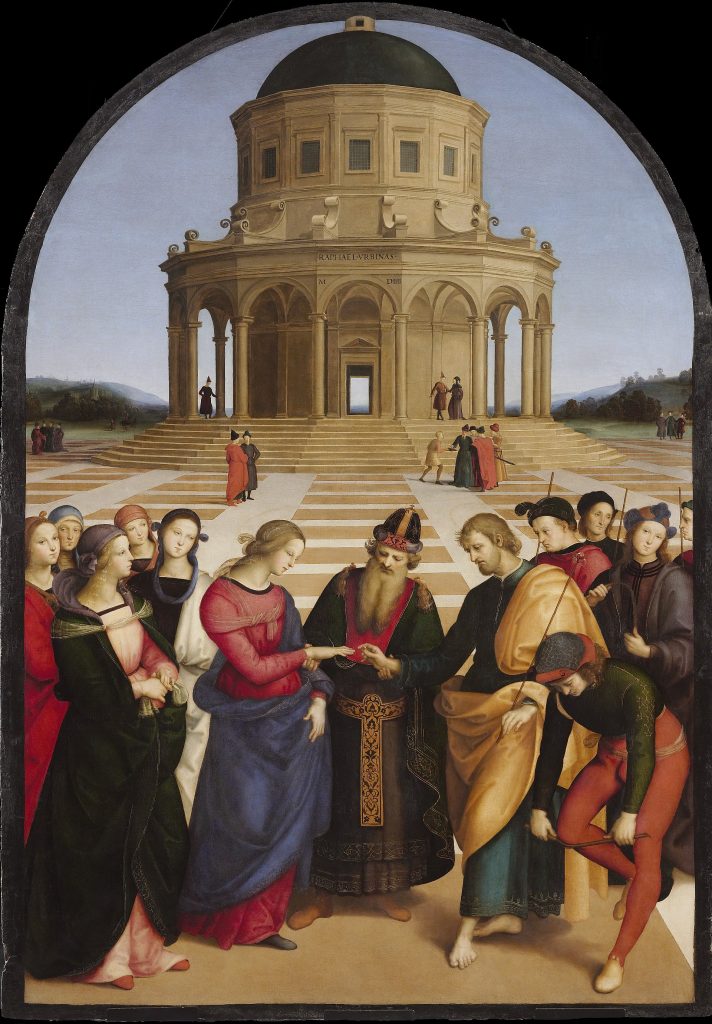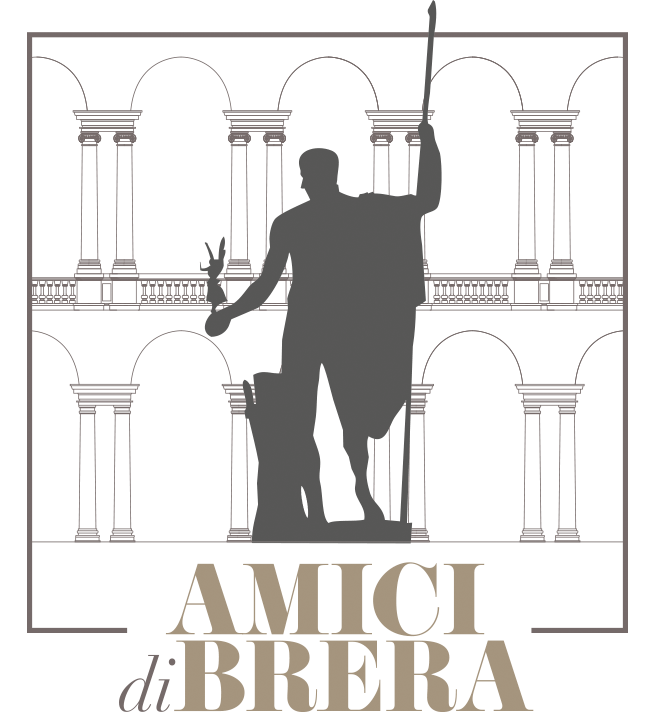Raffaello Sanzio (Raffaello Santi)/ Raphael
Urbino 1483 – Roma 1520
The Marriage of the Virgin
1504, signed and dated
Oil on panel
170×118 cm
Pinacoteca di Brera, from Città di Castello, San Francesco

PAINTING
The Marriage of the Virgin, commissioned by Lodovico Albizzini for San Francesco in Città di Castello, eloquently illustrates Raphael’s ability to assimilate – in an original way – the style of the most modern artists with whom he came into contact. The benchmark for comparison is a famous and almost contemporary work: the altarpiece (commissioned in 1499 and still unfinished in 1502, now in Caen Musée des Beaux Arts) painted by Perugino, the most famous painter in Italy at the time. It was intended for the chapel of the Perugia Cathedral, built in 1488 for the relic of the Sant’Anello, a seal from the Roman era believed to be Mary’s wedding ring. During this period, the Marriage of the Virgin was often set inside the Temple of Jerusalem. Perugino and Raphael, on the other hand, set it in a piazza in front of the building whose form is a reflection of the 15th-century architectural debate on the theme of the church with a central layout. Raphael shows a perfect understanding of the Umbrian’s sentimental classicism and, at the same time, achieves a more natural result due to his masterful handling of perspective and geometry. The piazza is open to the countryside, the pavement slabs climb towards the horizon beyond the Temple whose door coincides with the perspective vanishing point. The characters are arranged following the movement of the floor panels, with those in the foreground in a semicircle.
The story of the Marriage of the Virgin comes from the Apocryphon of John (2nd century), and was popularised by the Legenda Aurea by Jacopo da Varazze (late 13th century) and other texts. When Mary turned fourteen, according to the law of Moses, the high priest summoned the unmarried descendants of David to marry her. Each man brought a branch which was placed on the altar: the one whose branch miraculously blossomed would be chosen. In Raphael’s painting we see St Joseph with his flowering stick. On either side of the priest, bride and groom are Mary’s companions in the Temple and the disappointed suitors.
BIOGRAPHY
Raphael was born in Urbino in 1483, son of Giovanni Santi (1440/ 1445 – 1490), a distinguished painter of the Montefeltro court, man of letters and poet. Giorgio Vasari in his Lives of the Most Excellent Painters, Sculptors and Architects (1550 and 1568), states that Giovanni sent his son to Perugia as an apprentice to Pietro Vannucci. This information is not substantiated: in 1494, when his father died, Raphael was eleven years old. Nothing is known about him until December of 1500, when he signed the contract for the altarpiece with the Coronation of St Nicholas of Tolentino in the Baronci Chapel in Sant’Agostino in Città di Castello, with Evangelista di Piandimeleto, a former collaborator of Santi (fragments of the painting, damaged by an earthquake in 1789, are in the National Museum of Capodimonte in Naples, the Musée du Louvre in Paris and the Pinacoteca Tosio Martinengo in Brescia).
In the early 16th century, however, he was receptive to the main Umbrian painters: Luca Signorelli, Perugino and Bernardino di Betto, known as Pintoricchio. In 1502, with the latter, he worked in Siena on the Piccolomini Library in the Duomo and on the predella of the lost Sergardi altarpiece for San Francesco. As the Marriage of the Virgin in Brera shows, at this stage his assimilation of Perugino’s style is so pronounced that some critics consider the report of a period spent in his workshop to be reliable. Moreover, the young artist was heir to Urbino’s culture of perspective, which began with Piero della Francesca and Francesco di Giorgio Martini. But he was also familiar with Mantegna’s prints, and stayed abreast of studies in antiquity and architecture.
In autumn of 1504, Raphael moved to Florence where he lived until 1508, while still maintaining ties and commitments with Urbino and Perugia. His style changed when he saw the work of local 15th-century painters – Masaccio, Donatello, Luca Della Robbia – and the most modern masters of the time: Piero di Cosimo, Fra Bartolomeo, Michelangelo and Leonardo da Vinci. During this period, he painted The Deposition commissioned by Atalanta Baglioni for San Francesco in Prato in Perugia (Rome, Galleria Borghese), the Holy Family with a Lamb (Madrid, Museo del Prado), the so-called Belle Jardinière (Paris, Musée du Louvre), the Madonna of Orlèans (Chantilly, Musée Condé) the Portraits of Agnolo and Maddalena Doni (Florence, Uffizi Gallery), the Madonna of the Canopy for Santo Spirito (Florence, Palatine Gallery of Palazzo Pitti).
Raphael is documented as having been in Rome in 1509, commissioned to fresco the Stanza della Segnatura in the Vatican Palaces, by Pope Julius II. The pope quickly preferred him to other important artists he had previously hired to decorate his quarters. The work continued with the decoration of the Stanza di Eliodoro (completed in 1514), the Fire in the Borgo (by 1517) and Costantino, completed by collaborators after the artist’s death in 1520. Around 1512, Raphael collaborated on decorating the villa of the Sienese banker Agostino Chigi (la Faresina), with the fresco of the Triumph of Galatea. In 1514 he decorated the chapel of the same person in Santa Maria della Pace, perhaps also designing it. For Leo X, pope between 1513 and 1521, he designed Villa Madama, provided designs for the tapestries in the Sistine Chapel, frescoed the Vatican Loggias and painted the Portrait of Leo X with Cardinals Giulio de’ Medici and Luigi de’ Rossi (1518, Florence, Uffizi Gallery). The pontiff appointed him prefect of the Antiquities of Rome and architect of the Fabbrica di San Pietro. His last work was the Transfiguration (Vatican Museums), commissioned by Cardinal Giulio de’ Medici in 1518 for Narbonne Cathedral. It was still unfinished at Raphael’s death on 6 April 1520 and is housed in Rome in San Pietro in Montorio.
During his years in Rome, and also thanks to his study of ancient art, Raphael developed a classical style that would influence western art for centuries to come. Artists who worked with him on-site later become standard-bearers of his style: Giulio Romano, Giovan Francesco Penni, Giovanni da Udine and Polidoro da Caravaggio. His works achieved a vast and lasting popularity thanks to the prints made from his and his pupils’ drawings by Marcantonio Raimondi, Agostino Veneziano and other engravers.

